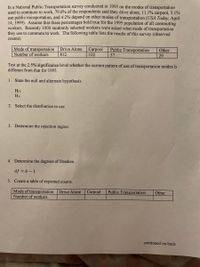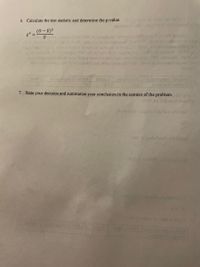
MATLAB: An Introduction with Applications
6th Edition
ISBN: 9781119256830
Author: Amos Gilat
Publisher: John Wiley & Sons Inc
expand_more
expand_more
format_list_bulleted
Concept explainers
Question

Transcribed Image Text:In a National Public Transportation survey conducted in 1995 on the modes of transportation
used to commute to work, 79.6% of the respondents said they drive alone, 11.1% carpool, 5.1%
use public transportation, and 4.2% depend on other modes of transportation (USA Today, April
14, 1999). Assume that these percentages hold true for the 1995 population of all commuting
workers. Recently 1000 randomly selected workers were asked what mode of transportation
they use to commute to work. The following table lists the results of this survey (observed
counts):
Mode of transportation
Number of workers
Сагроol
102
Public Transportation
Drive Alone
Other
812
57
29
Test at the 2.5% significance level whether the current pattern of use of transportation modes is
different from that for 1995.
1. State the null and alternate hypothesis.
Но:
HA:
2. Select the distribution to use.
3. Determine the rejection region.
4. Determine the degrees of freedom.
df = k - 1
5. Create a table of expected counts.
Mode of transportation Drive Alone
Number of workers
Public Transportation
Сагроol
Other
continued on back

Transcribed Image Text:6. Calculate the test statistic and determine the p-value.
(0 - E)?
x² =
re ln abom odio no
loome
no
7. State your decision and summarize your conclusion in the context of the problem. orh s
zieadhoqvleanmahs bas tun scrsta2
S of nonudidzib sdtoslo
noin noinsedi oiunC
b oldet a
Expert Solution
This question has been solved!
Explore an expertly crafted, step-by-step solution for a thorough understanding of key concepts.
This is a popular solution
Trending nowThis is a popular solution!
Step by stepSolved in 3 steps

Knowledge Booster
Learn more about
Need a deep-dive on the concept behind this application? Look no further. Learn more about this topic, statistics and related others by exploring similar questions and additional content below.Similar questions
- A report included data from a study in which 789 people in a representative sample of college students age 18 to 24 were asked how they perceive their money management skills. Possible responses were excellent, good, average, not very good, and poor. Each student in the sample was also classified by sex, resulting in the data in the table. Perception of Money Management Skills Not Very Good Excellent Good Average Poor Male 102 138 88 17 8 Female 81 193 136 22 4 Is there convincing evidence that there is an association between sex and how students perceive their money management skills? Test the relevant hypotheses using a significance level of a = 0.05. State the appropriate null and alternative hypotheses. O Ho: The proportions falling into each of the four perceptions of money management skills are the same for both sexes. H: The proportions falling into each of the four perceptions of money management skills are not the same for both sexes. O Ho: There is an association between sex…arrow_forwardData from the Bureau of Labor Statistics indicates that in a certain month, 36.8% of the labor force had a high school diploma or fewer years of education, 29.9% had some college or an associate's degree, and 33.3% had a bachelor's degree or more education. Of those with a high school diploma or fewer years of education, 6.8%were unemployed. Of those with some college or an associate's degree, 4.7% were unemployed, and of those with a bachelor's degree or more education, 2.9%were unemployed. Find the probability that a randomly chosen labor force participant has some college or an associate's degree given that he or she is unemployed.arrow_forwardBy a small margin, Facebook remains the top choice of social media over all ages, with 29% using Facebook most often among those using social media sites. However, more visually oriented social networks such as Snapchat and Instagram continue to draw in younger audiences. When asked "Which one social networking brand do you use most often?" the results in the table show the top brands chosen by Americans aged 12-34 who currently use any social networking site or service. Social M edia Site Faceboo k Snapchat Instagra m Twitter Percentage That Use Most Often 29 28 26 6 20 (a) What is the sum of the percentages for these top social media sites? Give your answer as an exact number. Macmillan Learning top social media sites: What percent of Americans aged 12-34 use other social media sites most often? Give your answer as an exact number. other social media sites: do %arrow_forward
- Data from the Bureau of Labor Statistics indicates that in a certain month, 35.7% of the labor force had a high school diploma or fewer years of education, 29.4% had some college or an associate's degree, and 34.9% had a bachelor's degree or more education. Of those with a high school diploma or fewer years of education, 5.5% were unemployed. Of those with some college or an associate's degree, 4.4% were unemployed, and of those with a bachelor's degree or more education, 2.4% were unemployed. Find the probability that a randomly chosen labor force participant has some college or an associate's degree given that he or she is unemployed. 12 The probability is 0 (Type an integer or decimal rounded to three decimal places as needed.)arrow_forwardMedical researchers followed 6272 Swedish men for 30 years to see if there was any association between the amount of fish in their diet and prostate cancer. (“Fatty Fish Consumption and Risk of Prostate Cancer,” Lancet, June 2001). A summary of the data is given in the table below. Fish Consumption No Prostate Cancers Prostate Cancers Never/Seldom 110 14 Small part of diet 2420 201 Moderate part of diet 2769 209 Large part of diet 507 42 A) If a patient is randomly selected, what is the probability that he/she had prostate cancer given that fish was never or seldom a part of the diet? Round your answer to three decimal places and include the leading zero. B) If a patient is randomly selected, what is the probability that s/he ate fish as a large part of their diet given that they had prostate cancer. Round your answer to two decimal places and include the leading zero.arrow_forwardA recent health survey 500 single young men yielded the following information: 385 were a member of a sports club, 155 were vegetarian, and 30 declined to answer the survey’s questions. What percent of the men were both members of a sports club and vegetarian? Draw a Venn diagram to illustrate the result of the survey.arrow_forward
- Is there a relation between incidents of child abuse and number of runaway children? A random sample of cities (over 10,000 population) gave the following information about the number of reported incidents of child abuse and the number of runaway children. (Reference: Federal Bureau of Investigation, U.S. Department of Justice.) City 1 2 3 4 5 6 7 8 9 10 11 12 13 14 15 Abuse cases 113 33 41 60 52 99 31 56 15 67 106 59 45 74 84 Runaways 648 188 285 687 421 590 284 277 162 473 600 432 317 580 592 Use a 1% level of significance to test the claim that there is a monotone-increasing relationship between the ranks of incidents of abuse and number of runaway children. (a) Rank-order abuse using 1 as the largest data value. Also rank-order runaways using 1 as the largest data value. Then construct a table of ranks to be used for a Spearman rank correlation test. City Abuse CasesRank x RunawaysRank y d = x - y d2 123456789101112131415 Σd2 = (b) What is the level of…arrow_forwardA tv report conducted a survey of 681 people in Washington state and found that 26% of the population believe that Mt Saint Helen's will have a repeat eruption this year. In the accompanying dialogue, the reporter states, we are 91% confident that the true proportion of people in Washington state who believe that Mt saint Helen's wil have a repeat eruption this year lies between 20% and 32%. What does 91% represent in the report?arrow_forwardA small college has been accused of gender bias in its admissions to graduate programs. a. Out of 500 men who applied, 255 were accepted. Out of 700 women who applied, 240 were accepted. Find the acceptance rate for each gender. Does this suggest bias? b. The college then looked at each of the two departments with graduate programs and found the data below. Compute the acceptance rate within each department by gender. Does this suggest bias? Department Men Women Applied Admitted Applied Admitted Dept A 400 240 100 90 Dept B 100 15 600 150 c. Looking at our results from Parts a and b, what can you conclude? Is there gender bias in this college’s admissions? If so, in which direction?arrow_forward
- Sierra College students enrolled in an online Elementary Statistics course were asked to participate in an anonymous onlne survey. The survey asked the students "Which type of device will you primarily use to access your online course in Canvas?". Of the 152 students who answered this question, 20 responded "a desktop computer", 121 responded "a laptop computer", 6 responded "a smartphone", and 5 responded "a tablet". The Sierra College Mathematics Department believes that less than 5% of students enrolled in an online Elementary Statistics course primarily uses a smartphone to access their online course in Canvas. Use the data collected in the survey to conduct a hypothesis testing procedure to test this belief. What conclusion should be reached according to the results of this hypothesis test?arrow_forwardA study was conducted to determine how people get jobs. The table list date from 400 randomly selected subjects. The data are bases on results from the National centter for Career Strategies. Job source of survey respondent FREQUENCIES HELP-WANTED ads 56 EXECUTIVE SEARCH FIRMS 44 NETWORKING 280 MASS MAILING 20 TOTAL 1. What percentage of the respondents got job by either help-wanted ads or mass mailing? 2. What percentage of the respondent got jobs from networking?arrow_forwardAssume that 135 surveys are completed. Of those surveyed, 61 responded positively to effectiveness, 65 responded positively to side effects, and 63 responded positively to cost. Also, 26 responded positively to both effectiveness and side effects, 29 to effectiveness and cost, 26 to side effects and cost, and 16 to none of the items. How many responded positively to all three?arrow_forward
arrow_back_ios
arrow_forward_ios
Recommended textbooks for you
 MATLAB: An Introduction with ApplicationsStatisticsISBN:9781119256830Author:Amos GilatPublisher:John Wiley & Sons Inc
MATLAB: An Introduction with ApplicationsStatisticsISBN:9781119256830Author:Amos GilatPublisher:John Wiley & Sons Inc Probability and Statistics for Engineering and th...StatisticsISBN:9781305251809Author:Jay L. DevorePublisher:Cengage Learning
Probability and Statistics for Engineering and th...StatisticsISBN:9781305251809Author:Jay L. DevorePublisher:Cengage Learning Statistics for The Behavioral Sciences (MindTap C...StatisticsISBN:9781305504912Author:Frederick J Gravetter, Larry B. WallnauPublisher:Cengage Learning
Statistics for The Behavioral Sciences (MindTap C...StatisticsISBN:9781305504912Author:Frederick J Gravetter, Larry B. WallnauPublisher:Cengage Learning Elementary Statistics: Picturing the World (7th E...StatisticsISBN:9780134683416Author:Ron Larson, Betsy FarberPublisher:PEARSON
Elementary Statistics: Picturing the World (7th E...StatisticsISBN:9780134683416Author:Ron Larson, Betsy FarberPublisher:PEARSON The Basic Practice of StatisticsStatisticsISBN:9781319042578Author:David S. Moore, William I. Notz, Michael A. FlignerPublisher:W. H. Freeman
The Basic Practice of StatisticsStatisticsISBN:9781319042578Author:David S. Moore, William I. Notz, Michael A. FlignerPublisher:W. H. Freeman Introduction to the Practice of StatisticsStatisticsISBN:9781319013387Author:David S. Moore, George P. McCabe, Bruce A. CraigPublisher:W. H. Freeman
Introduction to the Practice of StatisticsStatisticsISBN:9781319013387Author:David S. Moore, George P. McCabe, Bruce A. CraigPublisher:W. H. Freeman

MATLAB: An Introduction with Applications
Statistics
ISBN:9781119256830
Author:Amos Gilat
Publisher:John Wiley & Sons Inc

Probability and Statistics for Engineering and th...
Statistics
ISBN:9781305251809
Author:Jay L. Devore
Publisher:Cengage Learning

Statistics for The Behavioral Sciences (MindTap C...
Statistics
ISBN:9781305504912
Author:Frederick J Gravetter, Larry B. Wallnau
Publisher:Cengage Learning

Elementary Statistics: Picturing the World (7th E...
Statistics
ISBN:9780134683416
Author:Ron Larson, Betsy Farber
Publisher:PEARSON

The Basic Practice of Statistics
Statistics
ISBN:9781319042578
Author:David S. Moore, William I. Notz, Michael A. Fligner
Publisher:W. H. Freeman

Introduction to the Practice of Statistics
Statistics
ISBN:9781319013387
Author:David S. Moore, George P. McCabe, Bruce A. Craig
Publisher:W. H. Freeman